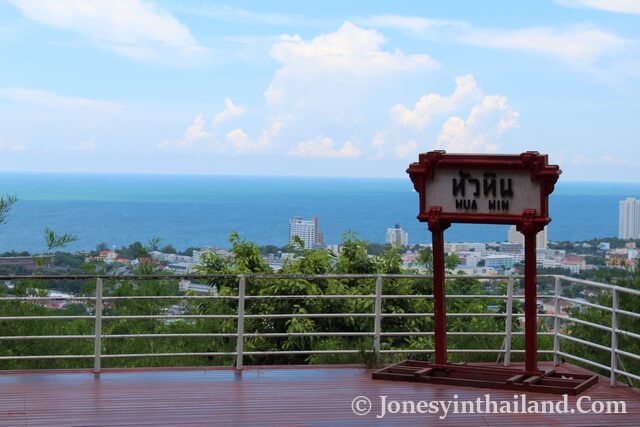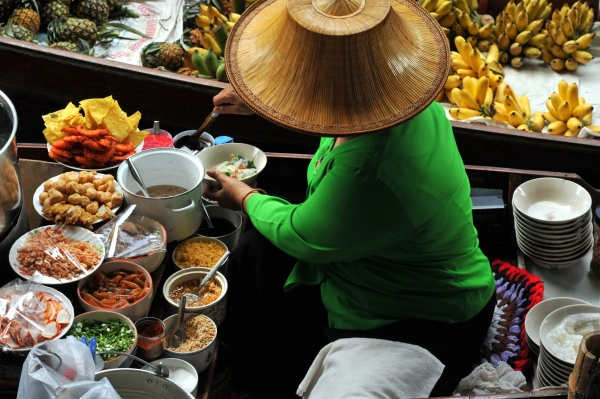12 Best Dishes & Foods to Try in Thailand
-- Last Updated on January 18, 2023 by Jonesy
It’s not exactly hard to find lashings of delightful food in Thailand. The difficulty lies more with trying to narrow it down to a short list–especially when it could be almost endless!
Let’s at least start with some of the staples across the nation–which originate in various parts of the country. Whether from northern, southern, central, or north-eastern regions, the flavours and tastes of all regions get a look in across the full Thai cuisine board.
If you’re new to Thai food then prepare to be delighted, but if you’re already a bit of a connoisseur you might find one or two of your favourites here. So let’s take a closer look at the top 12 dishes & foods to try in Thailand!
From the Central Regions of Thailand:
1. Thai Green Curry (Gaeng Keow Wan)
Possibly the best-known of all the Thai curries is this relatively spicy and creamy curry with its distinctive green hue. The creaminess is mainly due to the coconut milk used in the dish, and the colour is a result of the green chilli paste used as one of the base ingredients.
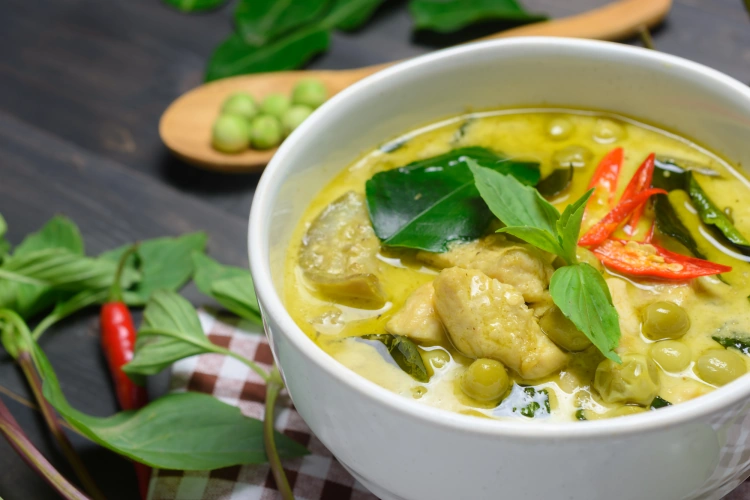
This is a dish that originates from Central Thailand. It thus has a few of its own subtle yet distinct flavours which come from the use of specific ingredients like shallots, lemon grass, coriander root, and a few others that all get combined with the green chilli paste and the coconut milk.
Thai Green Curry may vary slightly from restaurant to restaurant, as with the majority of Thai dishes. Some of the staple ingredients tend to include fresh herbs such as the leaves of sweet basil, with green eggplant being the most commonly-added vegetable.
The dish is made with virtually any kind of meat or seafood, but most often in Thailand it will be served with either chicken, or chicken balls/fish balls.
2. Thai Stir-Fried Noodles (Pad Thai)
Pad Thai is another well-known Thai dish that originates in the more centralised regions and it can be found pretty much anywhere. Again the ingredients tend to vary slightly between different restaurants and vendors, but many consider this something of a national dish–thus it is something of a staple in Bangkok.
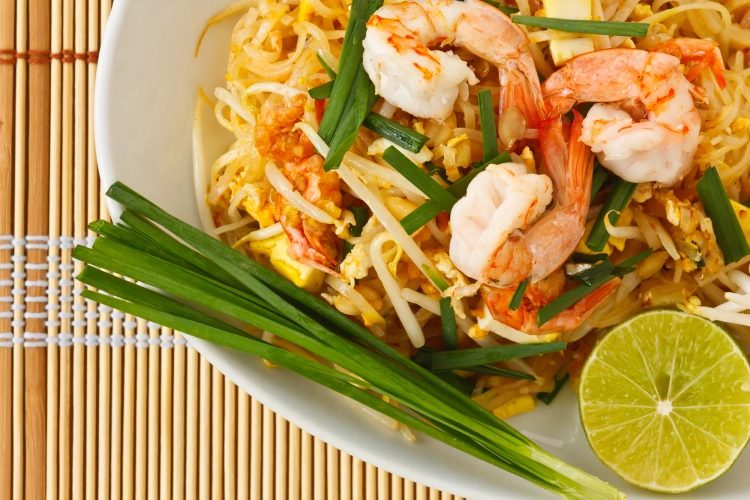
Although there is much variety and different levels of quality when it comes to noodle shops and vendors in Thailand. Pad Thai is most commonly found as a street food dish, and consists mainly of stir-fried, white, Thai rice noodles.
Some or all of the following ingredients may be included or some substituted for another addition: bean sprouts, chopped peanuts, shallots, tofu, prawns, egg, and tamarind sauce.
The result is a dish of many delightful flavours and textures that includes the sweet, spicy, and tangy citrus elements common to much traditional Thai food like this dish.
3. Stir-Fried ‘X’ with Basil (Pad Kra-Pow X)
Thai basil–known locally as ‘kra-pow’ is a type of herb commonly used in a lot of traditional Thai cuisine. For this particular dish it is considered the main source of flavour, along with varying degrees of chillies and garlic, according to the restaurant or your tastes.
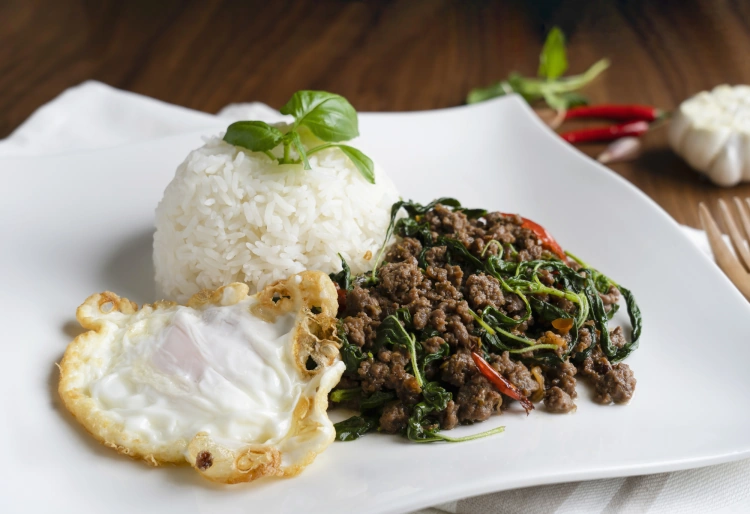
This is a very versatile dish that can be ordered with pretty much anything. Common options tend to be chicken, shrimps, crispy pork, and minced pork–even tofu for some non-meat eaters.
The meat is typically stir-fried with the basil leaves and a pungent mix of garlic and chillies and served on top of rice. Quite often a fried egg is ordered and placed on the top or the side. This dish might seem pretty spicy to a lot of visitors, although some vendors seem to take it upon themselves to either go light on the chillies when serving foreigners, or even omit them entirely!
Spicy in Thai is pet–so one thing that might be useful if you find yourself ordering food is to at least try and clarify the following when ordering:
- Mai pet (no chillies)
- Pet nit noy (a few chillies/a little bit spicy)
- Pet (spicy–if you dare)!
4. Braised Pork Leg on Rice (Khao Kha Moo)
Braised pork leg and rice is another Bangkok ‘staple.’ It is quite possibly Chinese in origin and is common in built-up, downtown areas with lots of street vendors or ‘hole-in-the-wall’ restaurants. The dish is also typically-found in the country’s multitude of food courts.
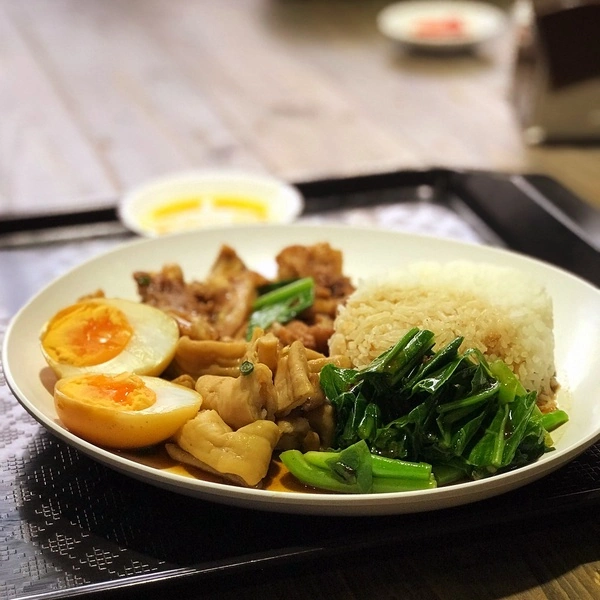
The real appeal of this long and slow-cooked dish is that the pork is super-tender and soft. It is braised in a sauce that is quite sweet, typically served with boiled eggs. A side garnish of raw garlic and small green chillies comes with it, as does a small serving of slightly sour and spicy sauce.
5. Spicy & Sour Soup with Shrimp (Tom Yum Goong)
As far as Thai food favourites and standards go, anyone who has ever set foot in a Thai restaurant in their own country has probably at least heard of Tom Yum. This is the hot, sour, and spicy Thai soup dish typically made with large shrimps.
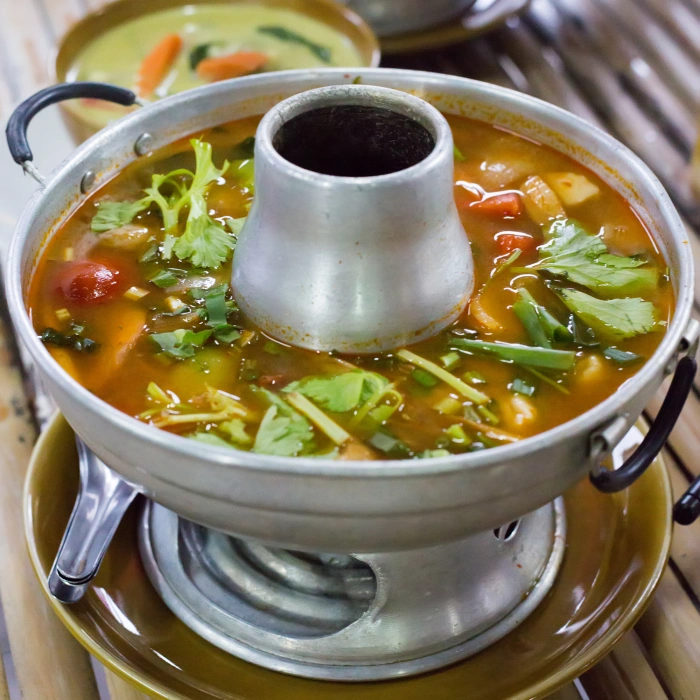
There are a few standard ingredients such as lemon grass, kaffir lime leaf, and with a few other strong Thai root herbs like galingale (sometimes ginger) tom yum has a particular tang to it. This is added to by the fresh chillies and chilli paste to facilitate the spice.
Tom yum is another dish common to the central regions which is usually available just about anywhere, especially in Bangkok. The degrees of spice and tang vary, with many ingredients that could be added to the basic Tom Yum formula
Various meats or seafood are typically used, or sometimes a mix of all (Tom Yum Ruam). Another point worth noting is that one version will have coconut milk, although sometimes canned, condensed milk is used, and another version will contain just hot water and is thus fairly clear.
If you have a preference you should try to highlight it. If the restaurant has English-speaking staff who are used to foreigners they may ask anyway which one you would like–but many would agree the coconut milk version definitely adds more ‘heartiness’ to the otherwise somewhat sparse soup.
- For the milky version, state: nahm con
- For the clearer version, state: nahm sai
Northern Varieties:
6. Noodle Soup Curry (Khao Soi)
Khao Soi is really a northern curry made with a spicy paste and coconut milk. You might call it something of a curry-based broth which also contains 2 different types of noodles (one of them crispy) and typically a chicken leg.
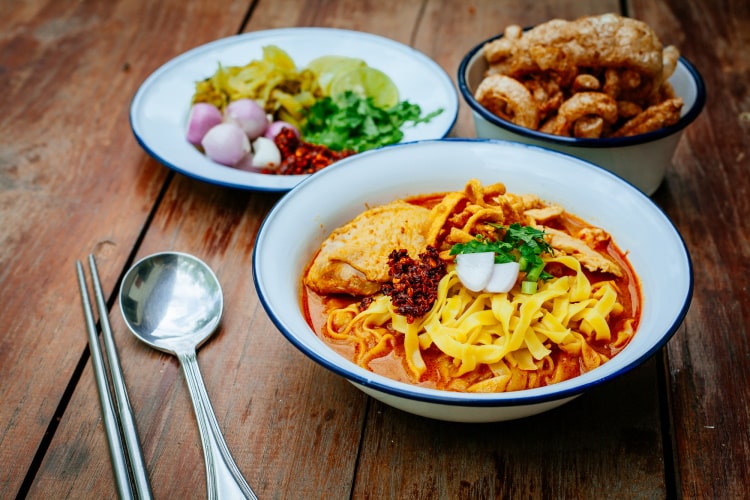
It’s fair to say that Khao Soi is one of the most popular and well-known Thai dishes from the northern regions. If you are a fan of Thai curry-type dishes you will love this. The meat is combined with a bowl of fresh long, yellow egg noodles, then topped with a handful of the delightfully crispy noodles that are one of the main traits of this dish.
The contrasts are amazing and the dish is typically accompanied by a small dish of freshly diced red onion, pickled greens, and a deep red chilli paste strong enough to blow off your head.
7. Northern Sausage (Sai Ooah)
There is usually some kind of variation on the sausage theme in every country, and the northern regions of Thailand are where the most popular one is from.
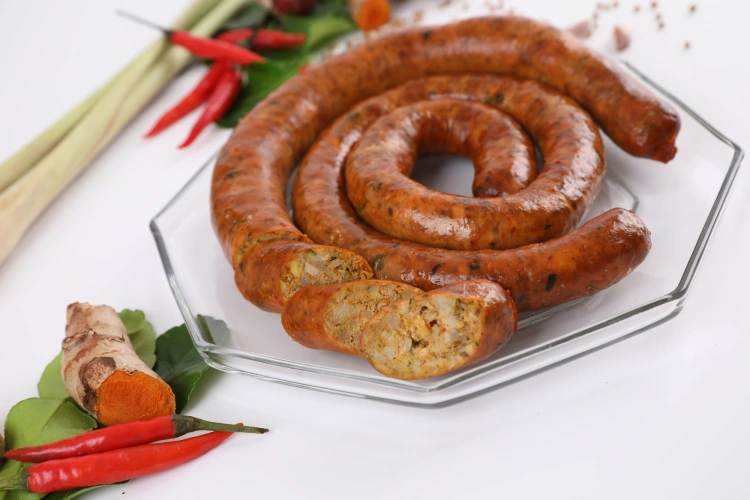
We might at least say that these are much closer to the ‘real’ variety of sausage, rather than the processed hot dog type found on the worst examples of Thai street vendors who deep-fry them–sometimes in days-old oil.
That said, while the general term for sausage in Thai is ‘sai-krawk’, the northern Thailand version has the further distinction of being known as ‘sai ooah’. This can be literally translated from Thai as stuffed intestines (sai) and the local word (ooah) means ‘to stuff’, which the sausages would have originally been made of.
Although they are still around, these days there are other ingredients as well like minced pork seasoned with garlic, herbs, red curry paste and chilli. This makes for a very tasty snack, especially if you like something with a bit of a bite.
The sai-ooah is recognisable from its colour which is a kind of charred red-brown (on the outside) and an orangey-yellow (inside). The sausage is typically made in and sold off long, circular coils that can be easily spotted.
These delights are served with a small bag or dish of fresh ginger and chillies, and are often enjoyed as an appetiser or a snack, and are particularly popular with beer and whisky drinkers.
North-Eastern Varieties:
8. Papaya Salad (Som Tum)
The spicy papaya salad, more commonly known as ‘Som Tum,’ is probably one of the most well-known exports of the North-east in Thailand. It is known as one of the country’s seriously-fiery dishes but the strength and flavours of the specific ingredients can vary greatly.
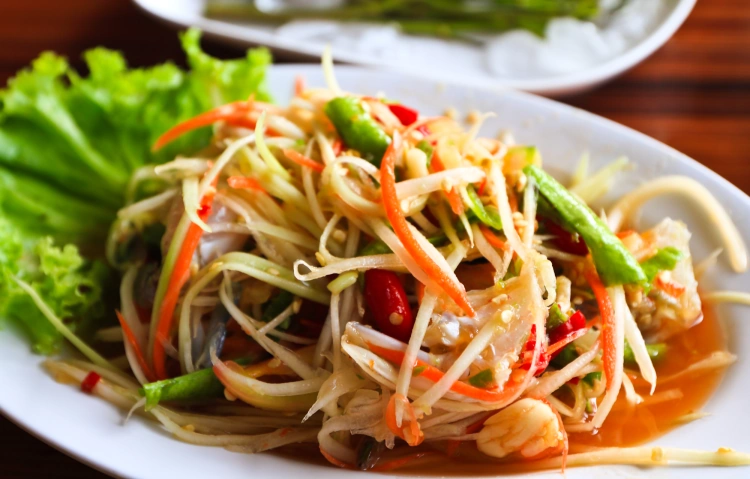
The prime ingredients of Som Tum are the chopped shreds of a papaya that is not yet ripe, giving it a crunchy consistency. Obviously a fair few chillies will feature–and in Thailand people generally tell them how many chillies to use.
Many vendors will often add heaps of sugar unless you tell them not too–mai dong sai nam tarn krap/ka. They will usually add in a chopped lime to add flavour, and sometimes a handful of peanuts.
9. Barbecued Chicken and Sticky Rice (Gai Yang Khao Neow)
The next most well-known dish from the north-east is Gai Yang Khao Neow, the barbecued chicken (often on a makeshift barbecue) prepared with various marinades.
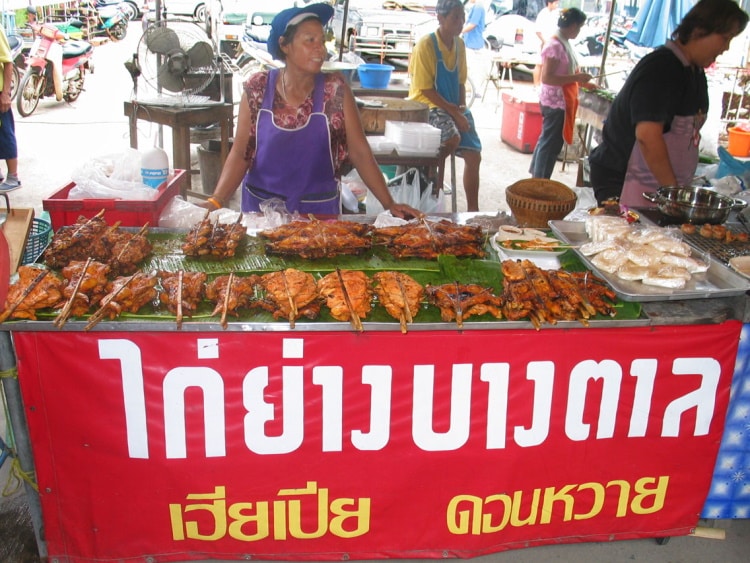
This will likely be a section of the chicken chopped and stretched out on special wooden sticks for barbecuing to perfection, although some vendors serve all different parts of a chicken from large to small, with obvious price variations.
It is much better if you are in Thailand to find a renowned restaurant selling this fare–there are many and picking up a couple of pieces from the guy with the small stand outside the 7-Eleven who has been there all day is probably not the best option.
The sticky rice is steamed, glutinous rice that is indeed ‘sticky’. The chicken is served with this along with a spicy dipping sauce. Som Tum is a common side dish and is usually on the menu in a restaurant that sells the chicken as they complement each other perfectly.
10. Spicy Minced Meat with Herbs (Laab)
There is no real translation into English of this particular word. It refers to a NE Thai dish that can be described as finely-chopped minced or ground meat (or fish) prepared with chillies, limes, shallots, coriander and something called Khao Krua (uncooked rice that is fried over a high heat, ground, and added to various dishes).
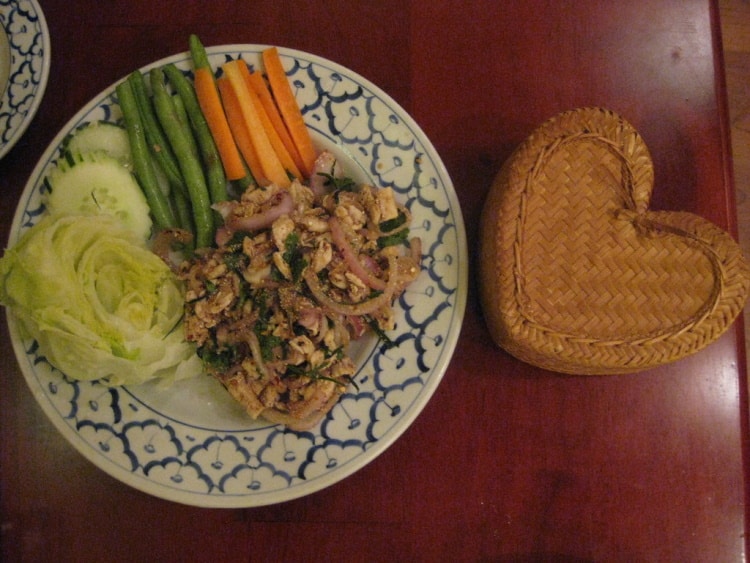
Laab is served with either sticky rice or regular rice, and usually also with various spicy dipping sauces. If you have even a slight penchant for spicy food you’ll find this quite delicious.
Southern Varieties:
11. Biryani Chicken & Rice (Khao Mok Gai)
Khao Mok Gai is the only dish in this whole list that doesn’t contain too much in the way of fiery spices and other strong flavours. In simple terms this is steamed chicken & rice with a hint of turmeric, which gives the fragrant rice the yellow hue.
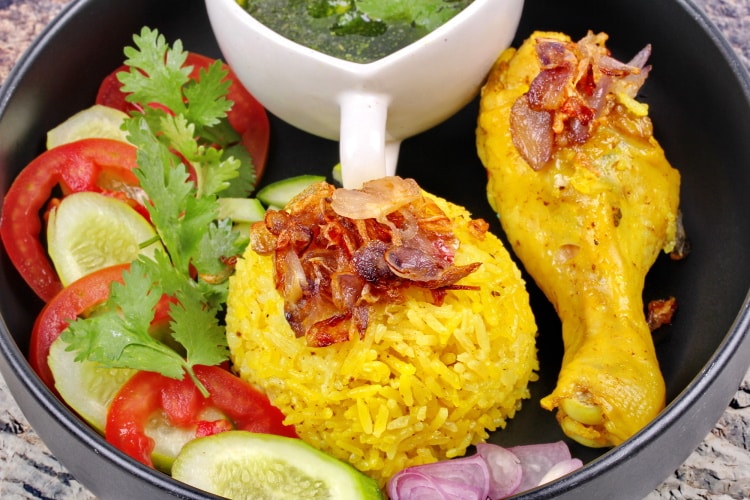
The rice is topped with the chicken and sprinkled with crispy fried shallots. It is also typically accompanied with sliced cucumbers and a sweet, green chilli dipping sauce. The flavours all combine perfectly, along with the small bowl of soup served with this dish.
The turmeric, along with a few other roasted herbs and spices (hence biriyani) make sure that the dish as a whole is packed with an intense, pungent and tasty flavour, regardless of the lack of strong tastes usually found in anything from the South of Thailand.
A little-known fact is that Biryani refers to the method of combining the rice and meat together with the unique blend of herbs and spices. Hence, the Thai name Kao (rice) Mok (bury) Gai (chicken), means chicken buried in rice.
12. Southern Spicy and Sour Orange Soup (Gaeng Som)
This is an example of a Thai ‘curry’ that is actually more of a soup, as there is no coconut milk added.
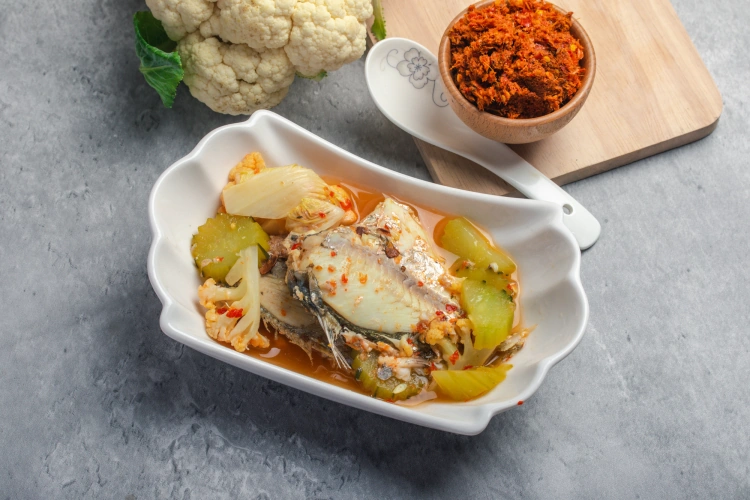
The chilli-paste base paste can make it a pretty spicy affair, depending on who makes it, but generally not too much. It’s worth noting though that any of the southern-style, water-based curries can often be pretty fiery options.
The sour aspect of Gaeng Som comes from tamarind, usually with some kind of tropical fruit like pineapple as well.
This Southern Thai curry is typically made with fish or shrimp and whichever local or southern vegetables considered suitable are available. Gaeng Som is one of those dishes from the south that is popular in central Thailand, and is usually found nationwide as standard Thai cuisine.

Mark Philip is a writer and lifestyle enthusiast from the Midlands in the U.K. With a background in martial arts and fitness, Mark upped sticks and headed out to Bangkok to delve a bit deeper into the art of Thai Boxing way back in the 2000s, starting to write initially to fund his daily training and escape the rigours of ESL teaching. Since then Mark has authored e-books, articles, and blogs across a wide range of topics for commercial, educational, factual, health & fitness, lifestyle, wellness, and leisure-based purposes.


